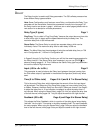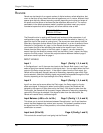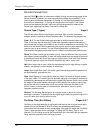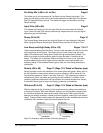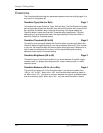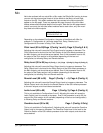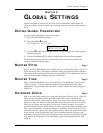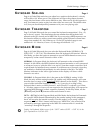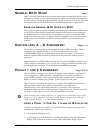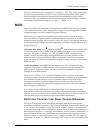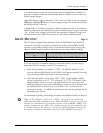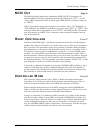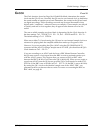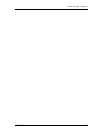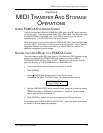
Global Settings: Chapter 8
QS7/QS8 Reference Manual 113113
KEYBOARD SCALING Page 4
Page 4 of Global Edit mode lets you adjust how sensitive the keyboardÕs velocity
will be (00 to 99). When set to 0, the keyboard will have the greatest dynamic
range, but loud notes will be more difficult to play. When set for 99, the opposite is
true: loud notes are easier to play but softer notes are not as soft. The default value
is 65, but you should adjust this parameter to fit your own playing style.
KEYBOARD TRANSPOSE Page 5
Page 5 of Global Edit mode lets you control the keyboard transposition (-12 to +12;
up or down 1 octave). This determines the note number that the keyboard will
transmit to the QSÕs sounds and to MIDI Out. If you are using a MIDI sequencer, use
this function when you wish to record notes outside of the keyboardÕs normal note
range (note numbers 36 Ð 96). When set to -12, the QS7 keyboard range is note
numbers 16 Ð 91. Likewise, if set to +12, the range would be 40 Ð 115.
KEYBOARD M ODE Page 6
Page 6 of Global Edit mode lets you select the Keyboard Mode (NORMAL, CH
SOLO, OUT 1 Ð OUT 16). This determines how the keyboard will function. When in
Mix Mode, you have the option to transmit on several MIDI channels at once, or to
temporarily isolate certain channels within a Mix.
NORMAL. In Program Mode, the keyboard will transmit on the selected MIDI
channel. In Mix Mode, the MIDI channels the keyboard transmits on will correspond
to whatever layers or splits the Mix is set up for. Note that certain controllers such
as pitch bend and aftertouch may transmit on a different set of channels, since they
are enabled or disabled independently for each channel of the Mix. The MIDI
Monitor indicators in the lower right section of the display will show which
channels are active.
CH SOLO. In Program Mode, this is the same as the NORMAL setting. In Mix
Mode, the only sounds coming from the QS, and the only MIDI messages, will come
from the layer or range of the underlined MIDI channel in the display. This allows
you to isolate individual channels in a Mix. So, if you play in a range of the
keyboard that is active on MIDI channel 1, and Channel 1 is selected, youÕll hear
it. All other ranges or layers will not respond to the keyboard (they will respond to
incoming MIDI messages on their respective channels). In Mix Play Mode, use the
[
▲
PAGE] and [PAGE
▲
] buttons to hear each channel in turn.
OUT 1 Ð OUT 16. In both Program Mode and Mix Mode, the keyboard will transmit
on a specific MIDI channel (determined by the number setting of this parameter),
but it will not play the internal sound(s). Use this mode if you're using a MIDI
sequencer with an ÒEchoÓ feature (also known as ÒMIDI ThruÓ); the sound will be
activated by messages appearing at the MIDI IN connector after itÕs made the
Òround tripÓ through the sequencer.
Setting the Keyboard Mode to one of the ÒOUTÓ values (OUT1 Ð OUT 16) is the
QSÕs equivalent to LOCAL OFF.
✪



